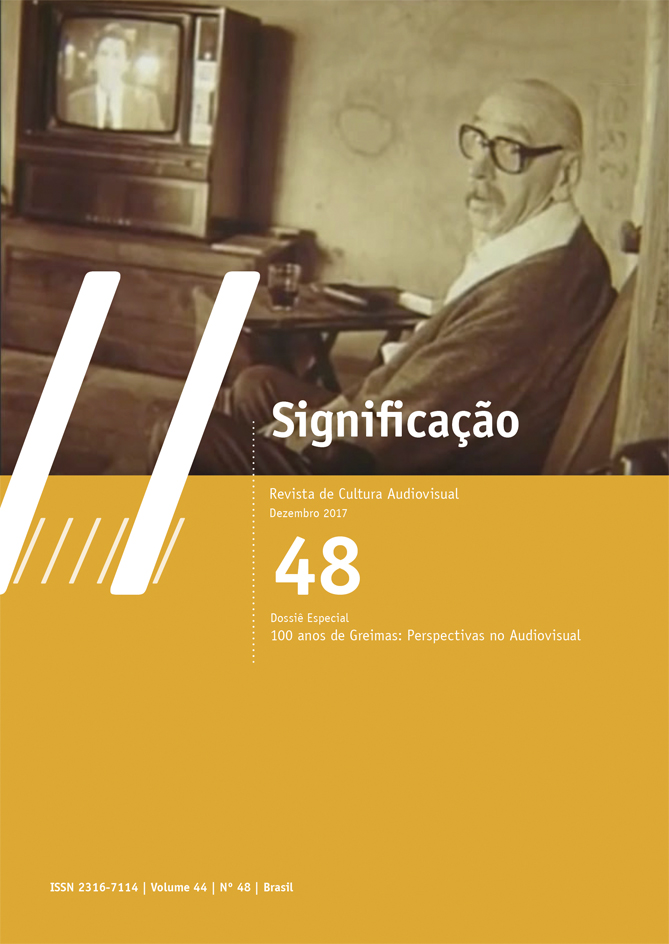Potentialities of “being” and “being not” and the “beau geste” between Io sono l’Amore and Amour
DOI:
https://doi.org/10.11606/issn.2316-7114.sig.2017.132941Keywords:
Greimas and the “beau geste”, social conventions, rupture and potency, contemporary practices, cinema and expressiveness.Abstract
The paper deals with the notion of the “beau geste”, firstly developed by Algirdas Julien Greimas and lately increased by Jacques Fontanille. The concept is taken here through the transversality of the idea of potency and contingency by the thought of Giorgio Agamben and articulated to two manifest empirical processes in the cinematographic expression of the films Io sono l’Amore and Amour. These examples are significative to show the ambivalent character of the so called “beau geste”, to inscribe in human actions the extreme possibility of social conventions’ rupture.
Downloads
References
AGAMBEN, G.; PAIXÃO, P. A. H. (Eds.). Bartleby, escrita da potência: Bartleby, ou da contingência, seguido de Bartleby, o escrivão de Herman Melville. Lisboa: Assírio e Alvim, 2008.
______. A potência do pensamento: ensaios e conferências. Belo Horizonte: Autêntica, 2015.DELEUZE, G.; GUATTARI, F. ¿Qué es la filosofía? 8. ed. Barcelona: Anagrama, 2009. p. 164-201. (Coleção Argumentos).
FONTANILLE, J. Formes de vie. Liège: Universitaires de Liège, 2015. (Série Sigilla).
GREIMAS, A.; FONTANILLE, J. “Le beau geste”. Recherches Sémiotiques: Semiotic Inquiry, Toronto, v. 13, n. 1-2, p. 21-35, 1993.
______. O belo gesto. In: NASCIMENTO, E. M. S. F.; ABRIATA, V. L. R. (Orgs.). Formas de vida: rotina e acontecimento. Ribeirão Preto: Coruja, 2014. p. 13-33.MELVILLE, H. Bartleby, o escrivão: uma história de Wall Street. São Paulo: Cosac Naify, 2005.
NASCIMENTO, E. M. S. F.; ABRIATA, V. L. R. (Orgs.). Formas de vida: rotina e acontecimento. Ribeirão Preto: Coruja, 2014.
RICOUER, P. Soi-même comme un autre. Paris: Seuil, 1990. (Série Ordre philosophique).
Referências audiovisuais
AMOUR (Amor). Michael Haneke, França; Alemanha; Áustria, 2012.
IO SONO l’Amore (Um sonho de amor). Luca Guadagnino, Itália, 2009.
Downloads
Published
Issue
Section
License
Copyright (c) 2017 Kati Eliana Caetano, Sandra Fischer

This work is licensed under a Creative Commons Attribution-NonCommercial 4.0 International License.
Authors who publish in this journal must agree with the following terms:
- Authors keep their copyrights and grant the journal first time publication rights, having their articles simultaneously licensed under the Creative Commons Attribution License, which allows sharing texts with authorship recognition and first publication on this journal for non-commercial purposes.
- Authors are allowed to make additional contracts, for a non-exclusive distribution of the article’s version published on this journal (e.g.: publishing in institutional repositories of articles or as a book chapter), with authorship recognition and first publication on this journal.
















